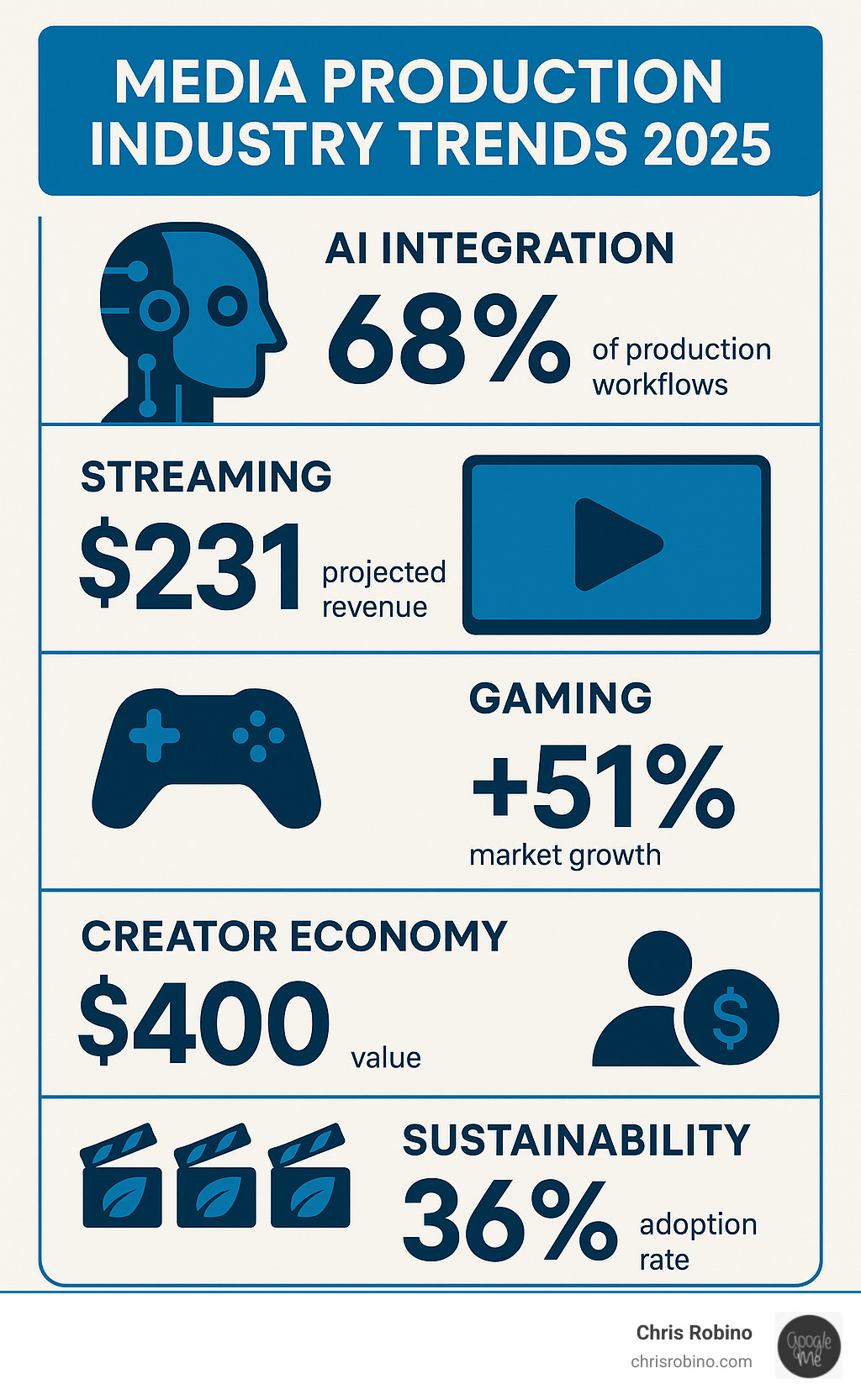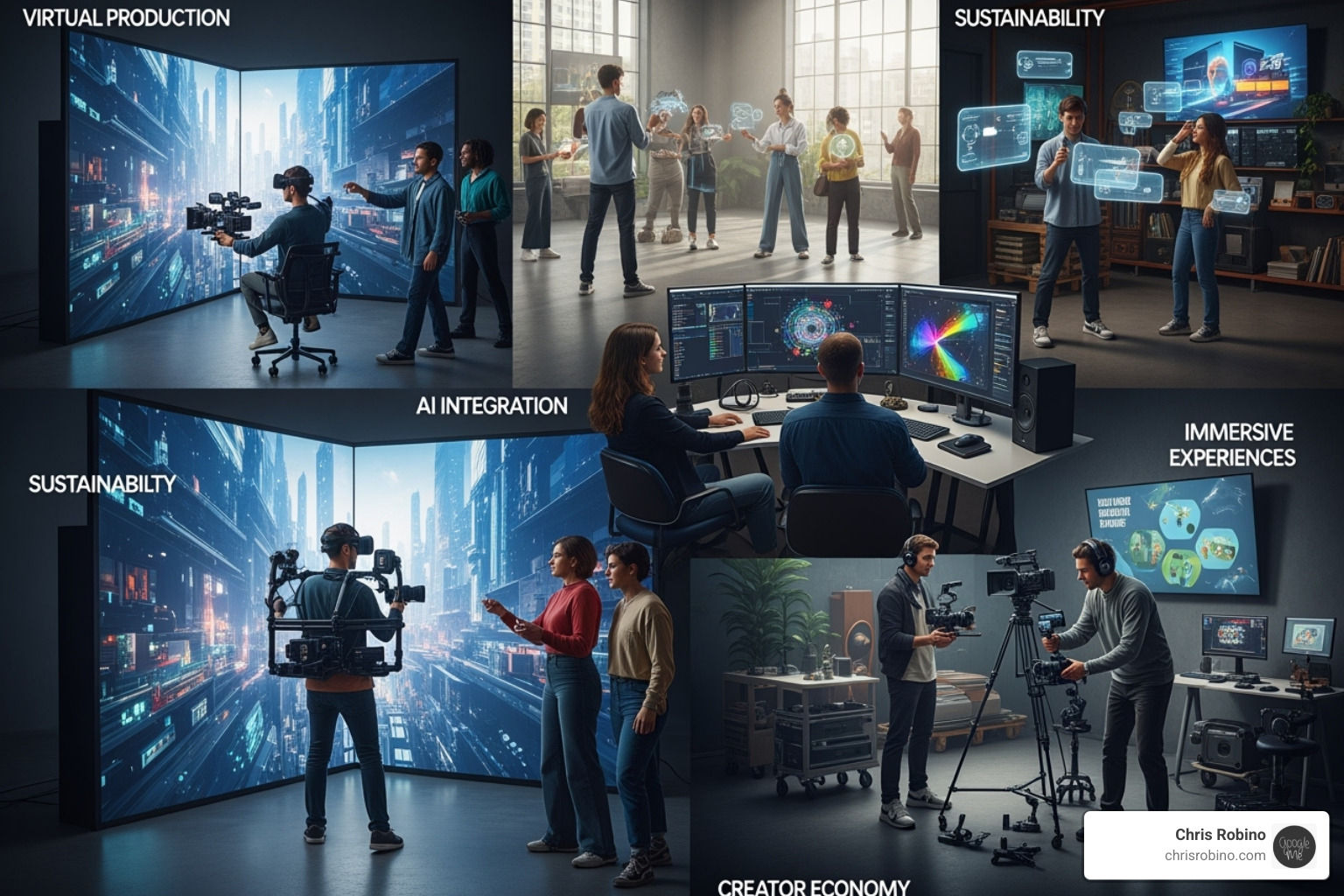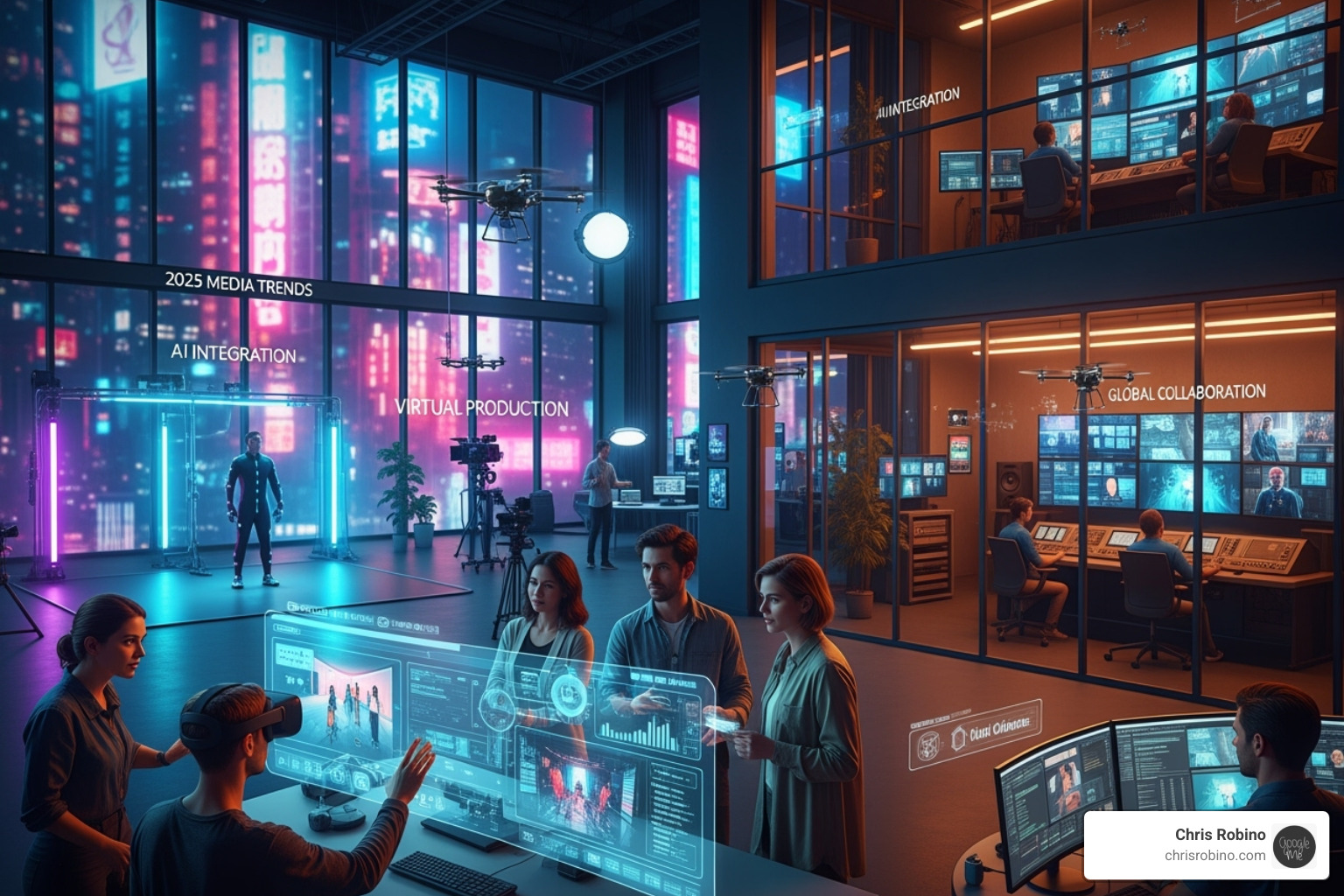Why Media Production Industry Trends 2025 Will Reshape Entertainment Forever
The media production industry trends 2025 represent a perfect storm of technological disruption and shifting consumer expectations. Here are the key developments reshaping entertainment:
Top 5 Media Production Trends for 2025:
- AI-Powered Production Workflows: From automated editing to AI-generated scripts.
- Cloud-Native and Remote Production: Decentralized teams using real-time collaboration tools.
- Hybrid Monetization Models: Combining subscriptions, ads, and micro-transactions.
- Immersive Content Experiences: AR/VR integration and interactive storytelling.
- Sustainability-First Production: Green practices driven by consumer demand and cost savings.
The numbers tell a compelling story. Media and entertainment industry revenue will surpass $3.4 trillion by 2028, yet 57% of executives believe their current business models may not survive the next decade. This isn’t just growth—it’s creative destruction on a massive scale, driven by technological convergence, new consumer demands, and intense economic pressures.
Traditional broadcasting is evolving into multi-platform media houses. Streaming platforms are adding ad-supported tiers, gaming revenue is rocketing toward $300 billion by 2028, and the creator economy could reach half a trillion dollars by 2027.
I’m Chris Robino, a Digital Strategy Leader and AI Expert with over two decades of experience helping organizations steer digital change and harness emerging technologies. I guide companies through the complexities of media production industry trends 2025, focusing on AI-driven solutions and strategic digital initiatives that maximize ROI.

Media production industry trends 2025 helpful reading:
The AI Revolution and Technological Disruption in Media Production
The landscape of media production is undergoing a seismic shift, with media production industry trends 2025 placing artificial intelligence at the center of this change. What once seemed like science fiction is now a reality in studios and newsrooms, fundamentally reimagining creative work from concept to delivery.

AI as a Creative Collaborator: A Core Media Production Industry Trend for 2025
AI is evolving from a simple tool into a creative partner. Generative AI helps screenwriters overcome writer’s block, while automated editing systems assemble rough cuts in minutes. AI-powered special effects create photorealistic environments that once took months, freeing artists to focus on creative vision.
Ethical considerations are paramount. The 2023 Hollywood writers’ strike highlighted the need for protections against AI replacing human talent. The consensus is that AI will augment human creativity, not replace it. Studios are adopting AI tools cautiously for content creation (under 3% of budgets in 2025) but are increasing spending on operational AI for tasks like contract management and marketing.
The key is balancing automation with human artistry. For organizations ready to explore this, AI-Driven Business Solutions offers practical implementation approaches.
The Shift to Cloud-Based Workflows and Interoperability
The days of being chained to an expensive editing suite are disappearing. Cloud-based workflows enable remote production teams to collaborate seamlessly worldwide. Decentralized teams can now work on the same project simultaneously, with editors, sound designers, and VFX artists collaborating in real-time using cloud-native tools.
The game-changer is interoperability. Media companies now demand open APIs and seamless integration to avoid vendor lock-in and use the best tools for each job. This shift lowers infrastructure costs, improves scalability, and requires significant change management. Mastering this transition offers a major competitive advantage. Understanding Moving from Ops System to Browser-Based to the Clouds is crucial for this shift.
Immersive Realities and the Future of Engagement
The line between watching and experiencing content is blurring. Augmented Reality (AR) and Virtual Reality (VR) are moving beyond gaming to create new ways for audiences to connect with stories. Virtual concerts and Metaverse experiences offer new revenue streams and deeper fan connections.
The monetization potential is enormous, with NFTs for fan engagement and blockchain for digital rights management creating more transparent systems. These technologies require investment, but early adopters are seeing returns. Aligning immersive tech with your audience and content strategy is key. Advanced Tech Solutions for Media Projects provides insights into this complex landscape.
The media production industry trends 2025 are clear: the future belongs to organizations that blend technology with creativity, leverage cloud flexibility, and create immersive experiences. The question is whether your organization will lead or follow.
Evolving Content Ecosystems: From Hyper-Local News to the Creator Economy
The content landscape is fundamentally shifting. As we move through 2025, audiences demand more personalized experiences, and creators are building authentic communities. This evolution is a significant media production industry trends 2025, blurring the line between professional and personal content.

The Rise of Hyper-Localization and Niche Audiences
While global media giants focus on broad stories, audiences are gravitating toward hyper-local content that speaks to their daily lives. Local news is experiencing a revival by offering relevance that national broadcasters cannot match. This focus on community storytelling builds deep, personal connections.
This trend extends to “micro-moments”—brief, personalized content interactions like a local traffic update. For media companies, this means serving underserved audiences. Mastering this approach builds loyal audiences and can significantly boost local SEO performance by capturing high-intent, location-based searches. Digital Strategy Advice can help companies develop these targeted approaches.
The Creator Economy’s Influence: A Key Media Production Industry Trend for 2025
The creator economy is reshaping media, projected to reach half a trillion dollars by 2027. This is a core media production industry trends 2025 that traditional media cannot ignore. Short-form, vertical video now dominates, and authenticity over polish is the new standard. User-generated content (UGC) often outperforms slick productions because it feels relatable.
Influencer marketing has evolved into authentic partnerships built on trust. Traditional media is adapting by embracing these formats and accessible tools, narrowing the gap between professional and consumer content creation. This shift directly impacts content strategy, as success now depends on creating content that feels genuine and performs well on social findy platforms.
Interactive Content and Gamification as Engagement Tools
Passive viewing is obsolete. Audiences want to participate. Interactive content and gamification are changing viewers into active participants. Real-time polls, choose-your-own-trip narratives, and viewer-driven story choices are becoming standard, making audiences feel invested.
Gamification now includes loyalty programs and community-building elements that create powerful social experiences. Media companies must rethink their content strategy to make audience participation a core component. The goal is to turn content into a rewarding brand interaction, fostering a community that returns for both the content and the connection.
The New Monetization Playbook for Media Production Industry Trends 2025
The media industry is at a critical juncture. Old revenue models are failing, with a recent survey finding that 57% of executives believe their current business models may not be viable in the next decade. This is forcing a complete rethink of revenue generation, with a shift toward diversified monetization strategies that adapt to new consumer behaviors and economic pressures.

Streaming’s Next Chapter: FAST, Bundling, and Hybrid Models
With the average household juggling multiple streaming subscriptions, subscription fatigue is a major challenge. The industry’s response includes several key strategies. Free Ad-Supported Streaming Television (FAST) offers free, linear-style content, attracting both viewers and advertisers.
The real game-changer is hybrid monetization. Companies are no longer choosing between subscriptions and ads; they’re offering both. For example, almost 40% of one major streaming service’s subscriptions will be ad-supported in 2025, a massive jump from 3% in 2022. Content bundling is another smart strategy, packaging multiple services to offer consumers convenience and value. Implementing these complex systems requires robust Cloud Solutions for Media to manage user tiers and content delivery.
Advertising’s Dominance and Smarter AdTech
Advertising will drive 55% of revenue expansion in media and entertainment over the next five years, making it a core strategy even for previously ad-free companies. This is a significant media production industry trends 2025.
As third-party cookies disappear, the industry is pivoting to privacy-first AdTech, relying on contextual targeting and first-party data. Connected TV (CTV) advertising combines digital’s precision with TV’s engagement, while shoppable content blurs the line between entertainment and e-commerce. AI-powered programmatic advertising is also getting smarter, optimizing ad targeting in real-time. This evolution presents a major opportunity for Innovation in Media Companies that accept these new approaches.
The Growing Importance of Sustainability in Media Production
Sustainability is now a business necessity, not just good PR. With studies showing that 34% of global consumers prefer sustainable brands, green practices impact the bottom line. Practically, climate change affects production schedules through extreme weather, making sustainable practices a form of risk management.
Green production methods like virtual production, renewable energy, and modular sets are becoming more cost-effective. The industry is moving toward carbon-neutral productions, giving early adopters a competitive advantage through both audience appeal and operational cost savings. This makes sustainability a crucial part of any media production industry trends 2025 strategy.
Expanding Universes: Gaming, Global Markets, and Strategic Alliances
The media landscape is exploding into new territories, driven by powerhouse sectors like gaming and strategic moves into emerging international markets. This expansion is reshaping entertainment, audience engagement, and global reach.
Gaming’s Unstoppable Growth as a Media Powerhouse
Gaming is now a dynamic force in media, projected to surpass $300 billion in revenue by 2028. The number of gamers worldwide is expected to top 3 billion by 2029, nearly 40% of the global population. This explosive growth is driven by social and casual gaming, which is making gaming a mainstream form of entertainment.
In-game advertising is a rapidly growing market, focusing on seamless brand integrations that improve the gaming experience. Esports broadcasting now rivals traditional sports coverage in sophistication, with mobile esports creating major entertainment hubs in emerging markets. As the line between gaming and traditional media blurs, companies are extending their franchises into gaming ecosystems, a crucial media production industry trends 2025 development. Smart companies can leverage this through Emerging Tech Insights.
Global Market Dynamics and Strategic Partnerships
While the US market is robust, the most exciting growth is in emerging markets like India, Indonesia, and Saudi Arabia, which have growth rates above 7.5%. China’s media revenues are also rising, fueled by internet advertising. These markets highlight the need for digital-first strategies for international success.
In response to competition, the industry is seeing more strategic consolidation and partnerships. Favorable conditions are encouraging mergers and acquisitions as companies seek to diversify revenue and gain market share. Experimental bundling partnerships are also serving as test beds for broader consolidation. This strategic maneuvering is about positioning for the next phase of media evolution. Companies that steer these dynamics will be best positioned for future growth, a topic covered in our Tech Industry Report.
Frequently Asked Questions about Media Production Trends
How is AI most likely to impact media production jobs in 2025?
In 2025, AI won’t be stealing jobs—it will be changing them. Think of AI as a creative assistant, not a replacement. It will automate tedious tasks in pre-production (script breakdowns, scheduling), production (real-time quality monitoring), and post-production (rough edits, color correction), freeing humans to focus on creative decisions.
Crucially, new roles are emerging, such as AI trainers, ethicists, and prompt engineers. These roles are becoming essential for the media production industry trends 2025. AI will augment human creativity by handling data-heavy tasks, allowing professionals to focus on storytelling and emotional connection.
What is the biggest challenge for streaming services in 2025?
Subscription fatigue is the biggest challenge. Consumers are overwhelmed by options and rising costs, leading to high churn rates as they jump between services for specific shows. The core issue is differentiation in a crowded market. When all services have “exclusive content,” it’s hard to stand out.
Successful platforms in 2025 will master hybrid monetization models (combining subscriptions, ads, and micro-transactions) and content bundling to provide clear value. They must answer a simple question for consumers: “Why should I keep paying for this service over all the others?”
Why is the creator economy so influential on traditional media?
The creator economy has rewritten the rules of audience engagement. Its influence stems from several factors:
- Authenticity Over Polish: Creators build deep connections with genuine, relatable content, training audiences to prefer it over slick corporate productions.
- Speed and Agility: Creators can react to trends in hours, mastering formats like short-form vertical video that traditional media is now adopting.
- Direct Audience Relationship: Creators bypass traditional gatekeepers, building a direct line to their audience for feedback and monetization.
- Innovation: Creators pioneer new monetization strategies (fan funding, brand partnerships) and serve as a massive talent pipeline, influencing traditional media to adapt.
Essentially, many media production industry trends 2025 are shaped by innovations that began with individual creators.
Conclusion
The future of media production is already here, demanding that leaders steer with agility and a willingness to accept radical change. The media production industry trends 2025 show an industry in constant motion, where standing still means falling behind.
These shifts are deeply interconnected. AI is becoming a creative collaborator, cloud workflows are enabling global teams, and immersive experiences are redefining audience engagement. On the business side, hybrid monetization is replacing traditional subscriptions, gaming has become an entertainment powerhouse, and the creator economy champions authenticity.
Adaptation is the only constant. Companies that thrive will be those that strategically accept change. This means reimagining business models, investing in privacy-first AdTech, and exploring global markets and strategic partnerships.
The media landscape of 2025 presents both immense challenges and unprecedented opportunities. For organizations ready to innovate, the potential for growth is extraordinary. The key is changing these challenges into competitive advantages.
That’s where our expertise comes in. We help companies steer these complex currents, turning technological disruption into strategic advantage. Whether you need guidance on AI implementation, cloud migration, or new business models, we can help you thrive in this dynamic environment.
For more insights, explore our reasonable tech questions, answers, how and why resources. The future of media production is being written now—let’s ensure you’re part of the story.

